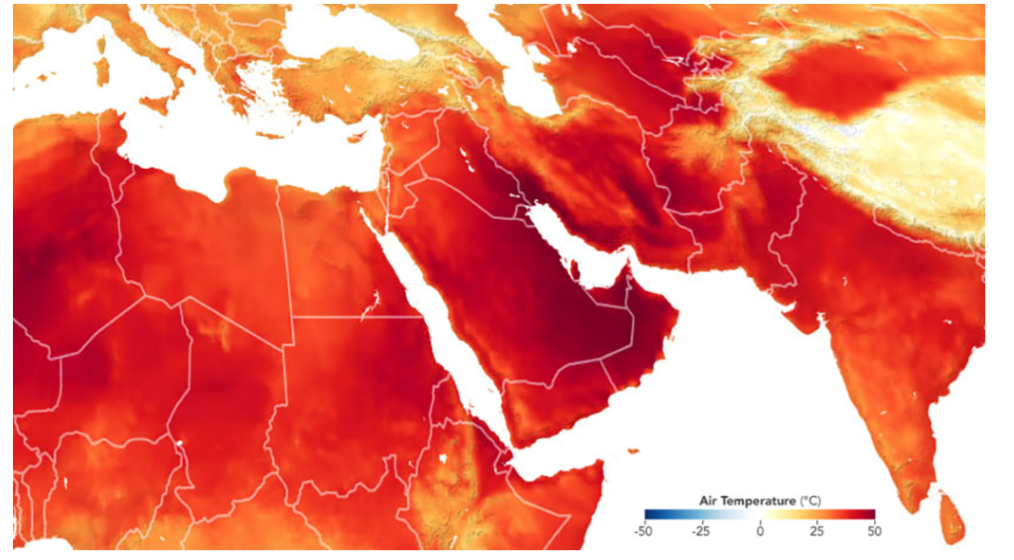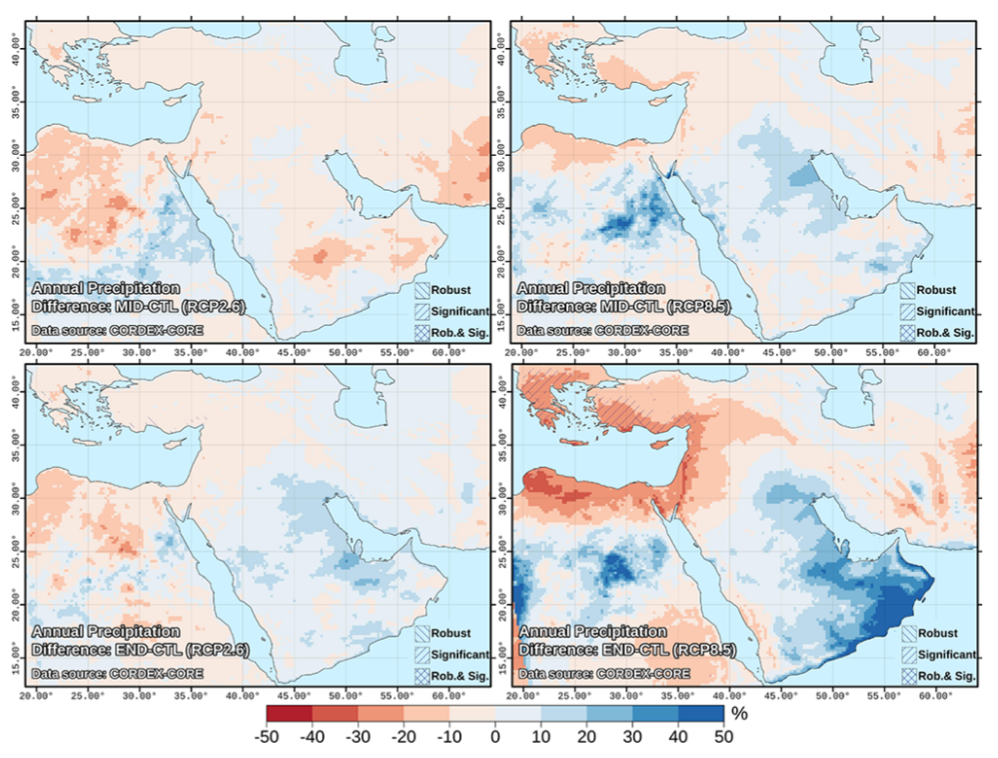Observational and modeling studies identify the Eastern Mediterranean and Middle East as a prominent climate change hotspot associated with weather extremes that have major impacts on society.
The responses to climate change due to anthropogenic greenhouse gas emissions are not uniformly distributed around the globe. Some regions, such as the Eastern Mediterranean and Middle East (EMME), warm more rapidly than the global mean.
A recent article published in Reviews of Geophysics explores how climate change is impacting the Eastern Mediterranean and Middle East. Here, we asked some of the authors about the rapid climate change in the EMME, advances in climate modelling in the region, and what challenges remain.
Why did you choose to study climate change in the Eastern Mediterranean and Middle East?
The EMME is located at an atmospheric crossroads, influenced by various atmospheric circulation patterns and meteorological processes between three continents, making climate studies both fascinating and challenging. The region is a major climate change hot spot that warms faster than other inhabited parts of the world.
The impacts of climate change in the EMME are compounded by specific challenges, including political tensions, social inequalities and limited access to resources. The scientific community in the region is committed to collaboration and help define both problems and solutions.
One such initiative that motivated the present study is a regional action plan by the Cyprus Government named ‘the Eastern Mediterranean and Middle East Climate Change Initiative‘.
What kind of climate does the EMME have now and how is it starting to change?
The EMME region includes a variety of climatic zones ranging from deserts and semi-arid zones in the south to sub-tropical and temperate climes. With warm to hot, dry summers, occasional droughts and mild, relatively wet winters, the climate of the northern EMME is primarily temperate.
Particularly during the past four decades, the region has experienced accelerated warming, almost two times faster than the global rate and more rapidly than Europe, North America and other regions. At the same time, changes in the hydrological cycle and rainfall characteristics have been observed, with parts of the region exposed to droughts, which are unprecedented during the period of instrumental records.

Model-calculated future changes of mean annual temperature (with respect to the 1986–2005 reference period). Left panels show a low greenhouse gas emission scenario (RCP2.6) and right panels a business-as-usual scenario (RCP8.5), for the mid-twenty-first century (top panels) and the end-of-century (bottom panels). Photo, Zittis et al. [2022], Figure 8.
What are some of the factors driving climate change in the EMME?
Several amplifying feedbacks contribute. The dominant forcing is the increase of greenhouse gases, responsible for most of the observed warming. Carbon dioxide and methane are emitted from the intensive exploitation and use of fossil fuels.
Fossil energy consumption is increasing rapidly in the region, also to provide fresh water and for cooling in summer. The EMME is becoming a dominant emitter of greenhouse gases, as emission rates are overtaking those in India and the European Union. Reduced aerosol pollution due to clean air policies in Europe has also contributed to regional warming in the Mediterranean area.
Other feedbacks include a strong land-atmosphere coupling in the wetter part of the region. When soil moisture runs out, sensible heating of the lower atmosphere increases, being most evident in the warm and dry season. In addition, land-use changes, mainly urbanization and abandonment of agricultural land, affect local climates.
Can recent extreme weather events can be attributed to climate change?
The EMME is becoming a dominant emitter of greenhouse gases, as emission rates are overtaking those in India and the European Union. Reduced aerosol pollution due to clean air policies in Europe has also contributed to regional warming in the Mediterranean area. Other feedbacks include a strong land-atmosphere coupling in the wetter part of the region.
When soil moisture runs out, sensible heating of the lower atmosphere increases, being most evident in the warm and dry season. In addition, land-use changes, mainly urbanization and abandonment of agricultural land, affect local climates.

Model-calculated future changes (in percent) of mean annual precipitation (with respect to the 1986–2005 reference period). Left panels show a low greenhouse gas emission scenario (RCP2.6) and right panels a business-as-usual scenario (RCP8.5), for the mid-twenty-first century (top panels) and the end-of-century (bottom panels). Picture, Zittis et al. [2022], Figure 12.
What are some of the societal impacts that these changing climatic conditions have had and will continue to have?
Virtually all socio-economic sectors and ecosystem services are challenged by rapid climate change in combination with other environmental factors.
Human health and well-being are directly impacted, mainly through heat stress and air pollution. Agriculture and aquaculture, hence food security, water availability, fire risk, growing energy needs and tourism in EMME countries are clearly challenged. Underprivileged communities in the urban, rural and coastal areas are most affected.
Transformational changes toward greater climate-resilience will widen the window of opportunity for societies and ecosystems to adapt to climate change. The primary way forward is to substantially reduce the emissions of greenhouse gases.
What kinds of advances have there been in climate modeling for this region?
Until about ten years ago, climate assessments for the region largely relied on coarse-resolution global model output. This was related to a lack of expertise and research in most EMME countries, and limitations of computational resources. Nowadays, there are several modelling groups active in the region. There have also been team efforts, such as the MENA-CORDEX initiative, coordinated by the by the Cyprus Institute.
High-resolution projections that include steep topographical and meteorological gradients, are needed to downscale climate change to the peculiarities of the EMME environment and inform governments and municipalities.
Advancements in modeling the societal impacts of climate change have also been achieved.
What are the major unsolved questions or knowledge gaps where additional research, data or modeling efforts are needed?
While temperature projections are robust, this is mostly not the case for precipitation.
Several factors contribute to uncertainties, including the local nature of rainfall, misrepresentation of orography and coastlines in models, and the sensitivity of precipitation calculations to the parametrizations of sub-grid-scale processes. Increasing the resolution of climate models will be an essential step forward, yet implies access to computational resources.
Most regional modeling efforts in the EMME have focused on the atmospheric part of the climate system.
Additional components such as marine, land and atmospheric chemistry processes are still insufficiently considered. The development of regional Earth system models is required, currently not available for the EMME.
The region is also subject to rapid population growth and urbanization. The combination, including the urban heat island effect and poor air quality, introduces major challenges. Resolving the urban environment in a climate modeling context will be of great help.
High-quality data collection and data sharing is another challenge. Finally, scientists need to contribute to awareness of climate change and engage in stakeholder involvement.
Citation: Zittis, G. and J. Lelieveld (2022), Eastern Mediterranean and Middle East face rapid climate change, Eos, 103, https://doi.org/10.1029/2022EO225026. Published on 25 August 2022.

